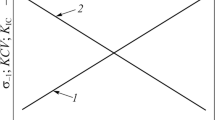We analyze the role of hydrogen in the in-service degradation of structural steels under climatic temperature conditions on a series of model examples. We develop an experimental express method for the simulation of the process of degradation of steel based on the artificial strain aging of the metal after its preliminary electrolytic hydrogenation and combining various mechanisms of degradation (strain hardening, aging, and development of dissipated damage). The method changes the state of the metal similarly to its long-term operation and enables one to predict the susceptibility of steels after operation to corrosion cracking.



Similar content being viewed by others
References
Z. T. Nazarchuk (editor), Technical Diagnostics of Materials and Structures. A Handbook [in Ukrainian], Vol. 1: E. I. Kryzhanivs’kyi, O. P. Ostash, H. M. Nykyforchyn, O. Z. Student, and P. V. Yasnii, In-Service Degradation of Structural Materials, Prostir-M, Lviv (2016).
Z. T. Nazarchuk and V. R. Skal’s’kyi, Acoustic Emission Diagnostics of Structural Elements: A Tutorial [in Ukrainian], Vol. 2: Methodology of Acoustic Emission Diagnostics, Naukova Dumka, Kyiv (2009).
G. Ya. Bezlyud’ko, V. F. Muzhitskii, and V. B. Remezov, “A series of portable devices (structurescopes) based on measuring the coercive force,” Kontr. Diagnost., No. 6, 7–10 (2003).
P. Ya. Krynychnyi and I. A. Molodets’kyi, “A device for monitoring the physicomechanical characteristics of pipes of the SIGMA-5T oil assortment,” Met. Pryl. Kontr. Yakosti, No. 2, 9–10 (1998).
O. M. Karpash, E. R. Dotsenko, and M. O. Karpash, “Complex method for checking physicomechanical characteristics of materials of metalworks,” Fiz.-Khim. Mekh. Mater., 47, No. 5, 13–18 (2011); English translation: Mater. Sci., 47, No. 5, 613–620 (2012).
Yu. V. Mil’man, H. M. Nykyforchyn, K. E. Hrinkevych, O. T. Tsyrul’nyk, I. V. Tkachenko, V. A. Voloshyn, and L. V Mordel’, “Assessment of the in-service degradation of pipeline steel by destructive and nondestructive methods,” Fiz.-Khim. Mekh. Mater., 47, No. 5, 13–18 (2011); English translation: Mater. Sci., 47, No. 5, 583–589 (2012).
O. T. Tsyrul’nyk, “Application of the electrochemical methods in the diagnostics of the engineering state of structural materials,” Fiz.-Khim. Mekh. Mater., 49, No. 4, 103–110 (2013); English translation: Mater. Sci., 49, No. 4, 449–460 (2014).
О. І. Zvirko, “Electrochemical methods for the evaluation of the degradation of structural steels intended for long-term operation,” Fiz.-Khim. Mekh. Mater., 52, No. 4, 26–31 (2016); English translation: Mater. Sci., 52, No. 4, 588–594 (2017).
GOST 7268-82. Steel. Method for the Evaluation of the Susceptibility to Mechanical Aging by Tests for Impact Bending [in Russian], Izd. Standartov, Moscow (1982).
A. H. Cottrell and B. A. Bilby, “Dislocation theory of yielding and strain ageing of iron,” Proc. Physical Soc., Sec. A, 62, 49–62 (1949).
A. Zagorski, H. Matysiak, O. Tsyrulnyk, O. Zvirko, H. Nykyforchyn, and K. Kurzydlowski, “Corrosion and stress corrosion cracking of exploited storage tank steel,” Fiz.-Khim. Mekh. Mater., 40, No. 3, 113–117 (2004).
O. T. Tsyrul’nyk, H. M. Nykyforchyn, O. I. Zvirko, and D. Yu. Petryna, “Embrittlement of the steel of an oil-trunk pipeline,” Fiz.-Khim. Mekh. Mater., 40, No. 2, 125–126 (2004); English translation: Mater. Sci., 40, No. 2, 302–304 (2004).
H. M. Nykyforchyn, K.-J. Kurzydlowski, and E. Lunarska, “Hydrogen degradation of steels under long-term in-service conditions,” in: S. A. Shipilov, R. H. Jones, J.-M. Olive, and R. B. Rebak (editors), Environment-Induced Cracking of Materials. Prediction, Industrial Developments and Evaluations, Vol. 2, Elsevier, Amsterdam (2008), pp. 349–361.
G. Gabetta, H. M. Nykyforchyn, E. Lunarska, P. P. Zonta, O. T. Tsyrulnyk, K. Nikiforov, M. I. Hredil, D. Yu. Petryna, and T. Vuherer, “In-service degradation of gas trunk pipeline X52 steel,” Fiz.-Khim. Mekh. Mater., 44, No. 1, 88–99 (2008); English translation: Mater. Sci., 44, No. 1, 104–119 (2008).
L. E. Kharchenko, O. E. Kunta, O. I. Zvirko, and R. S. Savula, “Diagnostics of hydrogen macrodelamination in the wall of a bent pipe in the system of gas mains,” Fiz.-Khim. Mekh. Mater., 51, No. 4, 84–90 (2015); English translation: Mater. Sci., 51, No. 4, 530–537 (2016).
H. Nykyforchyn, O. Zvirko, O. Tsyrulnyk, and N. Kret, “Analysis and mechanical properties characterization of operated gas main elbow with hydrogen assisted large-scale delamination,” Eng. Failure Anal., 82, 364–377 (2017).
H. M. Nykyforchyn, O. T. Tsyrul’nyk, V. A. Voloshyn, О. І. Zvirko, and M. I. Hredil’, A Method for Modeling the In-Service Degradation of Structural Steels of Main Pipelines [in Ukrainian], Patent of Ukraine No. 85446, МPК51 G01N 3/56, Publ. 25.11.13, Bull. No. 22.
O. I. Zvirko, S. F. Savula, V. M. Tsependa, G. Gabetta, and H. M. Nykyforchyn, “Stress corrosion cracking of gas pipeline steels of different strength,” Proc. Struct. Integrity, 2, 509–516 (2016).
H. M. Nykyforchyn, O. T. Tsyrul’nyk, O. I. Zvirko, and V. A. Voloshyn, “Diagnostics of the susceptibility of pipe steel to the degradation of properties caused by long-term operation,” Tekh. Diagnost. Nerazrush. Kontr., No. 3, 33–37 (2016).
H. Nykyforchyn, E. Lunarska, O. T. Tsyrulnyk, K. Nikiforov, M. E. Genarro, and G. Gabetta, “Environmentally assisted “in-bulk” steel degradation of long term service gas trunkline,” Eng. Failure Anal., 17, 624–632 (2010).
L. A. Efimenko, O. V. Konovalova, A. A. Yachinskii, O. I. Neifel’d, and Yu. D. Shapovalova, “Influence of strain hardening on changes in the structure and properties of the metal of pipelines made of 17GS steel,” Khim. Mashinostr., No. 4, 41–43 (2006).
V. I. Makhnenko, E. A. Velikoivanenko, and O. I. Oleinik, “Characteristics of fracture resistance of pipeline materials in the zone of defects; risk of refusal,” Avtomat. Svarka, No. 7, 5–14 (2008).
GOST 31447-2012. Interstate Standard. Steel Welded Pipes for Main Gas, Oil, and Oil-Trunk Pipelines. Technical Conditions [in Russian], Standartinform, Moscow (2013).
The present work was partially supported by the NATO in the Science for Peace and Security Program under the Project G5055.
Author information
Authors and Affiliations
Corresponding author
Additional information
Translated from Fizyko-Khimichna Mekhanika Materialiv, Vol. 53, No. 5, pp. 85–93, September–October, 2017.
Rights and permissions
About this article
Cite this article
Tsyrul’nyk, О.Т., Kret, N.V., Voloshyn, V.A. et al. A Procedure of Laboratory Degradation of Structural Steels. Mater Sci 53, 674–683 (2018). https://doi.org/10.1007/s11003-018-0123-1
Received:
Published:
Issue Date:
DOI: https://doi.org/10.1007/s11003-018-0123-1




